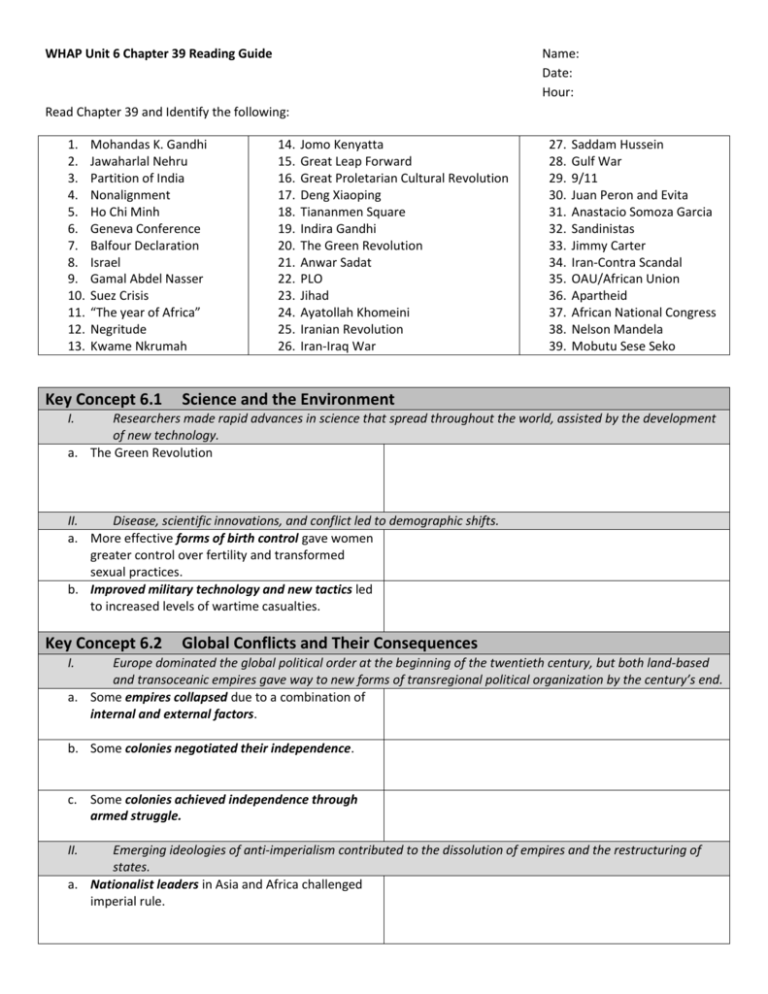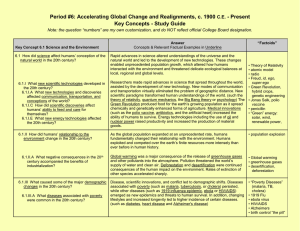Key Concept 6.2 Global Conflicts and Their Consequences
advertisement

WHAP Unit 6 Chapter 39 Reading Guide Name: Date: Hour: Read Chapter 39 and Identify the following: 1. 2. 3. 4. 5. 6. 7. 8. 9. 10. 11. 12. 13. Mohandas K. Gandhi Jawaharlal Nehru Partition of India Nonalignment Ho Chi Minh Geneva Conference Balfour Declaration Israel Gamal Abdel Nasser Suez Crisis “The year of Africa” Negritude Kwame Nkrumah Key Concept 6.1 14. 15. 16. 17. 18. 19. 20. 21. 22. 23. 24. 25. 26. Jomo Kenyatta Great Leap Forward Great Proletarian Cultural Revolution Deng Xiaoping Tiananmen Square Indira Gandhi The Green Revolution Anwar Sadat PLO Jihad Ayatollah Khomeini Iranian Revolution Iran-Iraq War 27. 28. 29. 30. 31. 32. 33. 34. 35. 36. 37. 38. 39. Saddam Hussein Gulf War 9/11 Juan Peron and Evita Anastacio Somoza Garcia Sandinistas Jimmy Carter Iran-Contra Scandal OAU/African Union Apartheid African National Congress Nelson Mandela Mobutu Sese Seko Science and the Environment I. Researchers made rapid advances in science that spread throughout the world, assisted by the development of new technology. a. The Green Revolution II. Disease, scientific innovations, and conflict led to demographic shifts. a. More effective forms of birth control gave women greater control over fertility and transformed sexual practices. b. Improved military technology and new tactics led to increased levels of wartime casualties. Key Concept 6.2 Global Conflicts and Their Consequences I. Europe dominated the global political order at the beginning of the twentieth century, but both land-based and transoceanic empires gave way to new forms of transregional political organization by the century’s end. a. Some empires collapsed due to a combination of internal and external factors. b. Some colonies negotiated their independence. c. Some colonies achieved independence through armed struggle. II. Emerging ideologies of anti-imperialism contributed to the dissolution of empires and the restructuring of states. a. Nationalist leaders in Asia and Africa challenged imperial rule. b. Regional, religious, and ethnic movements challenged both colonial rule and inherited imperial boundaries. c. Transnational movements sought to unite people across national boundaries. d. Movements to redistribute land and resources developed within some states, sometimes advocating communism and socialism. III. Political changes were accompanied by major demographic and social consequences. a. The redrawing of old colonial boundaries led to population resettlements. b. The migration of former colonial subjects to imperial metropoles maintained cultural and economic ties between the colony and the metropole even after the dissolution of empires. c. The proliferation of conflicts led to various forms of ethnic violence and the displacement of peoples resulting in refugee populations. IV. Military conflicts occurred on an unprecedented global scale. a. The sources of global conflict in the first half of the century varied. (causes) b. The global balance of economic and political power shifted after the end of WWII and rapidly evolved into the Cold War. The United States and the Soviet Union emerged as superpowers, which led to ideological struggles between capitalism and communism throughout the globe. c. The Cold War produced new military alliances and promoted proxy wars. V. a. b. c. d. Although conflict dominated much of the twentieth century, many individuals and groups---including states--opposed this trend. Some individuals and groups, however, intensified the conflicts. Groups and individuals challenged the many wars of the century, and some promoted the practice of nonviolence as a way to bring about political change. Groups and individuals opposed and promoted alternatives to the existing economic, political, and social orders. Militaries and militarized states often responded to the proliferation of conflicts in ways that further intensified conflict. More movements used violence against civilians to achieve political aims. e. Global conflicts had a profound influence on popular culture. Key Concept 6.3 I. New Conceptualizations of Global Economy, Society, and Culture States responded in a variety of ways to the economic challenges of the twentieth century. a. In the Communist states of the Soviet Union and China, governments controlled their b. c. II. a. b. c. d. e. III. a. national economies. In newly independent states after World War II, governments often took on a strong role in guiding economic life to promote development. At the end of the twentieth century, many governments encouraged free market economic policies and promoted economic liberalization. States, communities, and individuals became increasingly interdependent, a process facilitated by the growth of institutions of global governance. New international organizations formed to maintain world peace and to facilitate international cooperation. New economic institutions sought to spread the principles and practices associated with free market economics throughout the world. Humanitarian organizations developed to respond to humanitarian crises throughout the world. Regional trade agreements created regional trading blocs designed to promote the movement of capital and goods across national borders. Movements throughout the world protested the inequality of environmental and economic consequences of global integration. People conceptualized society and culture in new ways; some challenged old assumptions about race, class, gender, and religion, often using new technologies to spread reconfigured traditions. The notion of human rights gained traction throughout the world. b. Increased interactions among diverse peoples sometimes led to the formation of new cultural identities and exclusionary reactions. c. Believers developed new forms of spirituality and chose to emphasize particular aspects of practice within existing faiths and apply them to political issues. IV. Popular and consumer culture became global. a. Sports were more widely practiced and reflected national and social aspirations. b. Changes in communication and transportation technology enabled the widespread diffusion of music and film.











